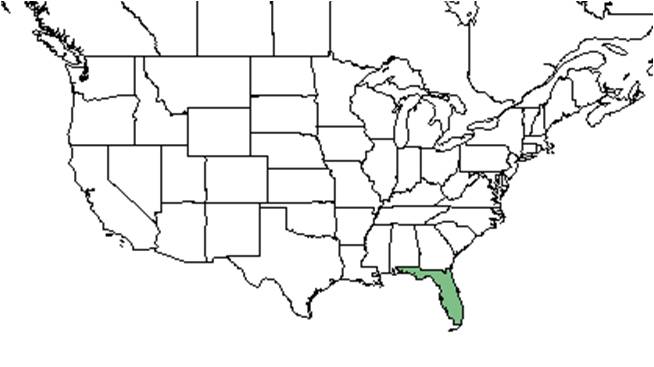Difference between revisions of "Eryngium cuneifolium"
KatieMccoy (talk | contribs) (→Description) |
KatieMccoy (talk | contribs) (→Description) |
||
| Line 23: | Line 23: | ||
<!-- Basic life history facts such as annual/perrenial, monoecious/dioecious, root morphology, seed type, etc. --> | <!-- Basic life history facts such as annual/perrenial, monoecious/dioecious, root morphology, seed type, etc. --> | ||
It is a aromatic perennial herb with a basal rosette <ref name="FWS"/> that starts flowering 2 to 3 years after germination (Menges and Quintana-Ascencio 2004). It is endemic to the pyrogenic ''Ceratiola'' scrubs of the southern portion of the Lake Wales ridge and has developed a long, woody taproot to cope with the limited nutrient and water availability (Menges and Quintana-Ascencio 2004). Basal leaves are long, stalked and shaped like narrow wedges with 3 to 5 bristle-tipped teeth at the apex <ref name="FWS"/>. | It is a aromatic perennial herb with a basal rosette <ref name="FWS"/> that starts flowering 2 to 3 years after germination (Menges and Quintana-Ascencio 2004). It is endemic to the pyrogenic ''Ceratiola'' scrubs of the southern portion of the Lake Wales ridge and has developed a long, woody taproot to cope with the limited nutrient and water availability (Menges and Quintana-Ascencio 2004). Basal leaves are long, stalked and shaped like narrow wedges with 3 to 5 bristle-tipped teeth at the apex <ref name="FWS"/>. | ||
| + | Perfect flower are arranged in a compound umbel and are small with white petals, filaments, styles and stigmas<ref name="EOL">[[http://eol.org/pages/581797/details Encyclopedia of Life]]</ref><ref name="FWS"/>. | ||
==Distribution== | ==Distribution== | ||
Revision as of 17:36, 14 December 2015
| Eryngium cuneifolium | |
|---|---|
Error creating thumbnail: Unable to save thumbnail to destination
| |
| Scientific classification | |
| Kingdom: | Plantae |
| Division: | Magnoliophyta - Flowering plants |
| Class: | Magnoliopsida - Dicotyledons |
| Order: | Apiales |
| Family: | Apiaceae ⁄ Umbelliferae |
| Genus: | Eryngium |
| Species: | E. cuneifolium |
| Binomial name | |
| Eryngium cuneifolium Small | |

| |
| Natural range of Eryngium cuneifolium from USDA NRCS Plants Database. | |
Common name: wedgeleaf eryngo
Contents
Taxonomic notes
Description
It is a aromatic perennial herb with a basal rosette [1] that starts flowering 2 to 3 years after germination (Menges and Quintana-Ascencio 2004). It is endemic to the pyrogenic Ceratiola scrubs of the southern portion of the Lake Wales ridge and has developed a long, woody taproot to cope with the limited nutrient and water availability (Menges and Quintana-Ascencio 2004). Basal leaves are long, stalked and shaped like narrow wedges with 3 to 5 bristle-tipped teeth at the apex [1]. Perfect flower are arranged in a compound umbel and are small with white petals, filaments, styles and stigmas[2][1].
Distribution
Eryngium cuneifolium is limited to a narrow geographic range in the southern portion of the Lake Wales Ridge in Ceratiola scrubs [1].
Ecology
Habitat
In the Coastal Plain in Florida, E. cuneifolium has been found in well drained sandy soils in exposed openings of scrubs (FSU Herbarium). Associated species include Pinus elliottii, P. clausa, Quercus myrtifolia, Bumelia tenax, Persea palustris, Lyonia, Palafocia feayi, Sabal etonia,and Polygonella fimbriata (FSU Herbarium).
Phenology
Flowers and fruits April through November (FSU Herbarium).
Seed dispersal
Seed bank and germination
Fire ecology
Pollination
The following Hymenoptera families and species were observed visiting flowers of Eryngium cuneifolium at Archbold Biological Station (Deyrup 2015):
Apidae: Bombus pennsylvanicus
Colletidae: Colletes mandibularis
Halictidae: Augochlora pura, Augochlorella aurata, Augochloropsis sumptuosa, Lasioglossum miniatulus, L. nymphalis, L. placidensis, Sphecodes heraclei
Leucospididae: Leucospis affinis, L. robertsoni, L. slossonae
Megachilidae: Anthidiellum perplexum, Coelioxys mexicana, C. octodentata, C. sayi, Dianthidium floridiense, Megachile albitarsis, M. brevis pseudobrevis, M. mendica, M. texana
Pompilidae: Episyron conterminus posterus
Sphecidae: Anacrabro ocellatus, Bembix sayi, Bicyrtes capnoptera, Cerceris blakei, C. flavofasciata floridensis, Ectemnius rufipes ais, Isodontia exornata, Oxybelus laetus fulvipes, Philanthus politus, Prionyx thomae, Sphex ichneumoneus, Tachysphex similis, Tachytes guatemalensis, T. validus
Vespidae: Euodynerus boscii boharti, E. castigatus rubrivestris, Pachodynerus erynnis, Polistes perplexus
Use by animals
Diseases and parasites
Conservation and Management
Cultivation and restoration
Photo Gallery
References and notes
Deyrup, M.A. and N.D. 2015. Database of observations of Hymenoptera visitations to flowers of plants on Archbold Biological Station, Florida, USA.
Florida State University Robert K. Godfrey Herbarium database. URL: http://herbarium.bio.fsu.edu. Last accessed: October 2015. Collectors: Beverly Judd, Walter S. Judd, R. Kral, Siri von Reis. States and Counties: Florida: Highlands, St. Lucie. Compiled by Tall Timbers Research Station and Land Conservancy.